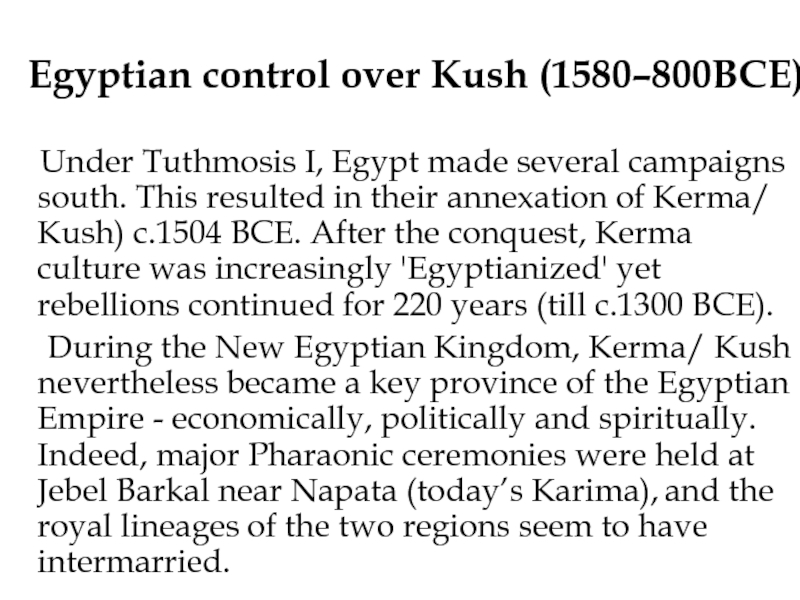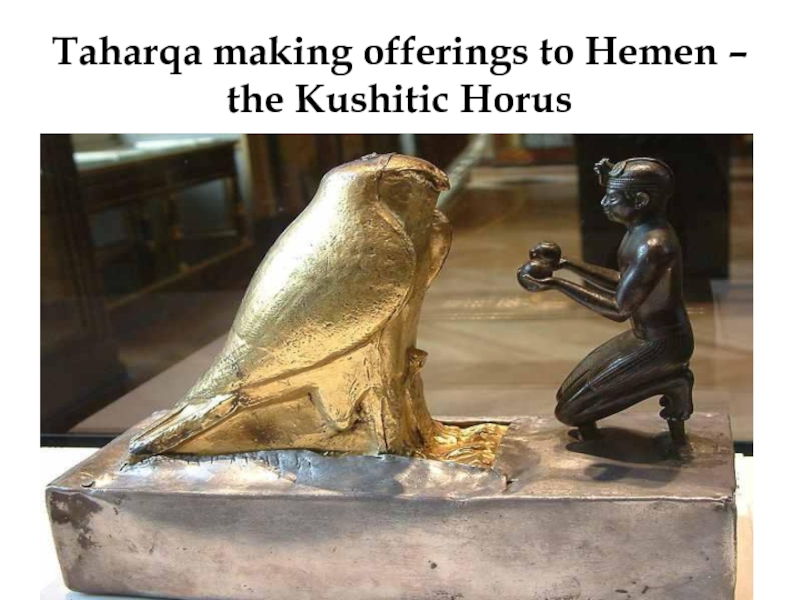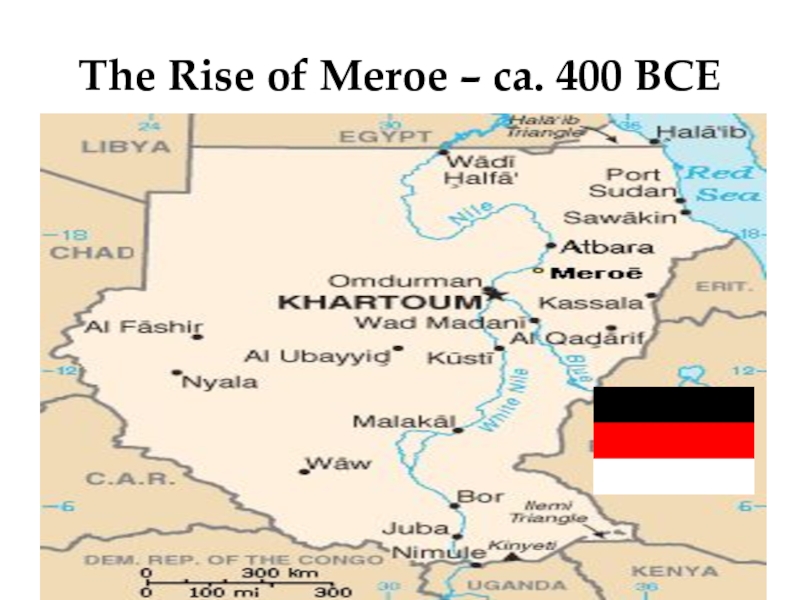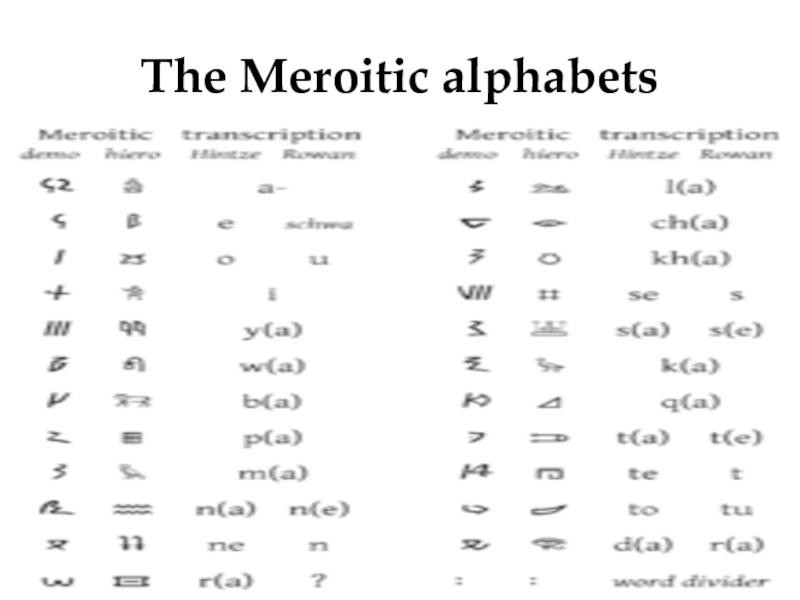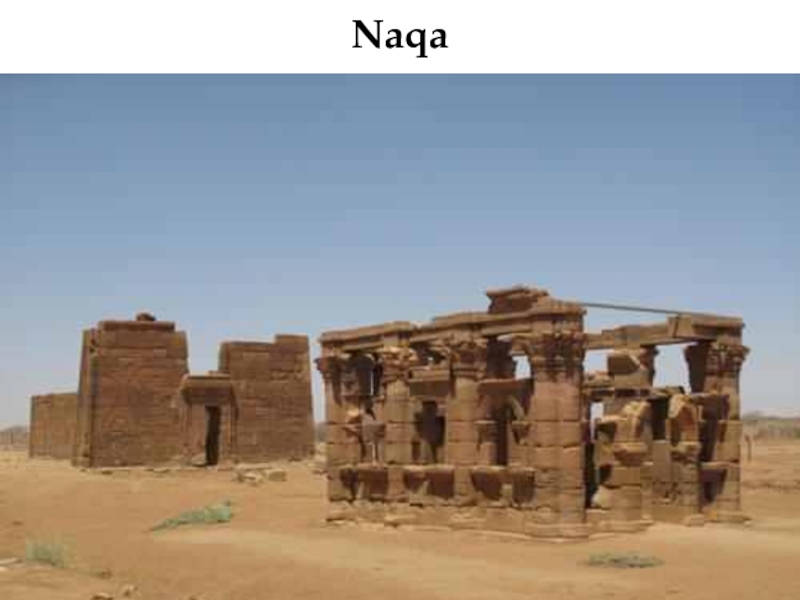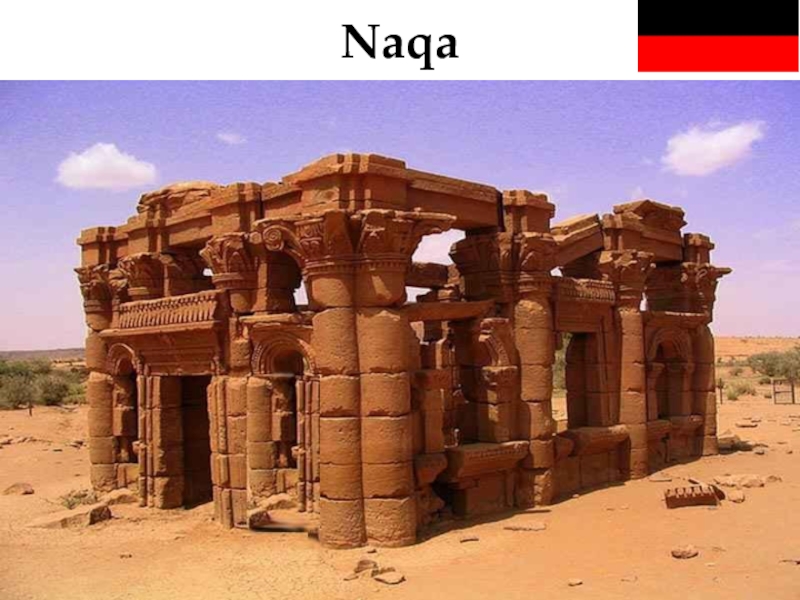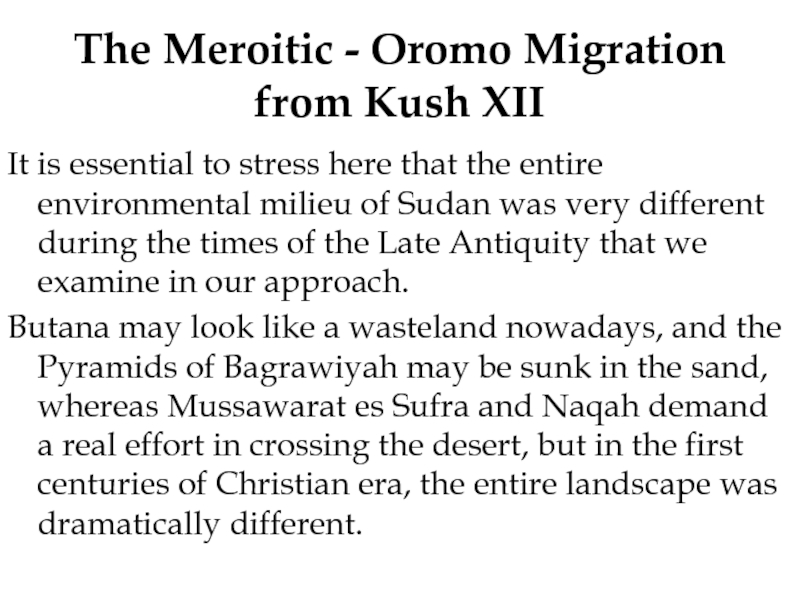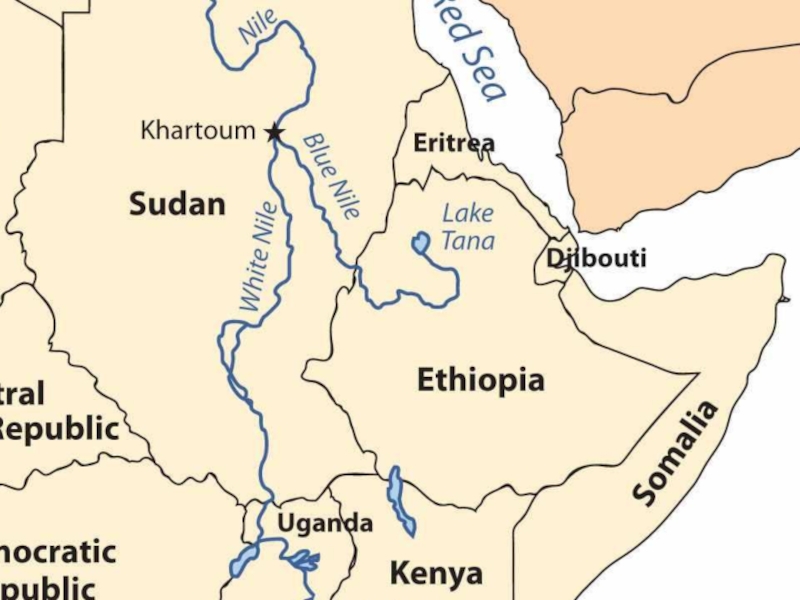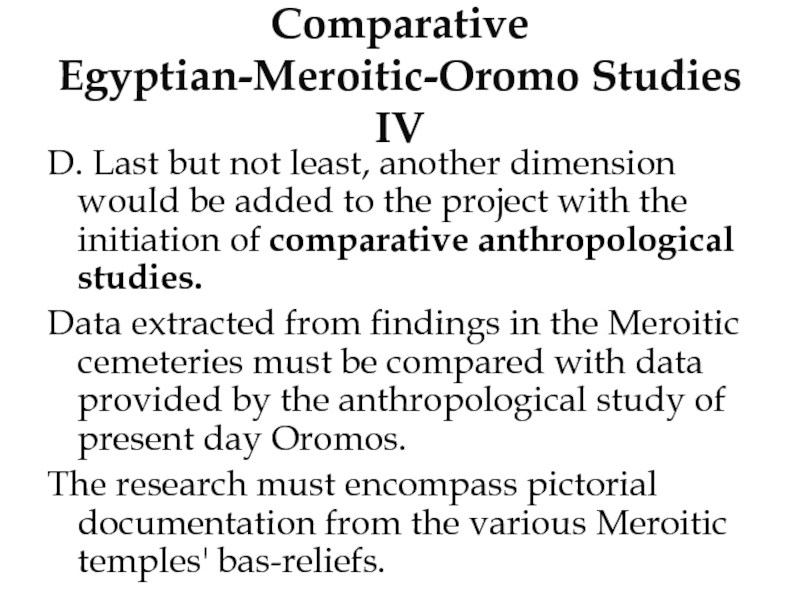Слайд 1Ancient Oromo History
A reconstruction
Слайд 6Kingdom of Kerma (2050-1580 BCE)
Around 3000 B.C., a town began
to develop near the Neolithic dwellings.
Pre-Kerma (c. 3500-2500BC) No C-Group
Phase
Early Kerma (c. 2500-2050BC) C-Group Phase Ia-Ib
Middle Kerma (c. 2050-1750BC) C-Group Phase Ib-IIa
Classic Kerma (c. 1750-1580BC) C-Group Phase IIb-III
Final Kerma (c. 1580-1500BC) C-Group Phase IIb-III
Late Kerma – ‘New Kingdom’ (c.1500-1100?BC) ‘New Kingdom’
Слайд 7Kingdom of Kerma (2050-1580 BCE)
Слайд 8Kingdom of Kerma (2050-1580 BCE)
Слайд 9Kingdom of Kerma (2050-1580 BCE)
Слайд 10Egyptian control over Kush (1580–800BCE)
Under Tuthmosis I, Egypt
made several campaigns south. This resulted in their annexation of
Kerma/ Kush) c.1504 BCE. After the conquest, Kerma culture was increasingly 'Egyptianized' yet rebellions continued for 220 years (till c.1300 BCE).
During the New Egyptian Kingdom, Kerma/ Kush nevertheless became a key province of the Egyptian Empire - economically, politically and spiritually. Indeed, major Pharaonic ceremonies were held at Jebel Barkal near Napata (today’s Karima), and the royal lineages of the two regions seem to have intermarried.
Слайд 11Kushitic Dynasty and the rule over Upper Egypt (760 -
666 BCE)
Слайд 13Example of fake maps made up because of political agendas
Слайд 14Taharqa with Queen Takahatamun at Jebel Barkal Temple - Napata
Слайд 16Taharqa followed by his mother Queen Abar. Jebel Barkal -
room C
Слайд 17Taharqa making offerings to Hemen – the Kushitic Horus
Слайд 20Meroitic Language: Ancient Afaan Oromo
Despite the fact that F. L.
Griffith has identified the 23 Meroitic alphabetic scripture’s signs already
in 1909, not much progress has been made towards an ultimate decipherment of the Meroitic.
Scarcity of epigraphic evidence plays a certain role in this regard, since as late as the year 2000 we were not able to accumulate more than 1278 texts.
If we now add to that the lack of lengthy texts, the lack of any bilingual text (not necessarily Egyptian /Meroitic, it could be Ancient Greek / Meroitic, if we take into consideration that Arkamaniqo / Ergamenes was well versed in Greek), and a certain lack of academic vision, we understand why the state of our knowledge about the history of the Meroites is still so limited.
Слайд 21Meroe - According to partially deciphered Meroitic texts, the name
of the city was Medewi or Bedewi
Слайд 33The End of Meroe I
Amidst numerous unclear points of the
Kushitic / Meroitic history, the end of Meroe, and the
consequences of this event remain a most controversial point among scholars. Quite indicatively, we may mention here the main efforts of historical reconstitution.
A. Arkell, Sayce and others asserted that Meroe was captured and destroyed, following one military expedition led by Ezana of Axum.
B. Reisner insisted that, after Ezana’s invasion and victory, Meroe remained a state with another dynasty tributary to Axum.
Слайд 34The End of Meroe II
C. Monneret de Villard
and Hintze affirmed that Meroe was totally destroyed before Ezana’s
invasion, due to an earlier Axumite Abyssinian raid.
D. Torok, Shinnie, Kirwan, Haegg and others concluded that Meroe was defeated by a predecessor of Ezana, and continued existing as a vassal state.
E. Bechhaus- Gerst specified that Meroe was invaded prior to Ezana’s raid, and that the Axumite invasion did not reach lands further in the north of Meroe.
Слайд 35The End of Meroe III
With two fragmentary inscriptions from
Meroe, one from Axum, two graffitos from Kawa and Meroe,
and one coin being all the evidence we have so far, we have little to reconstruct the details that led to the collapse of Meroe.
One relevant source, the Inscription of Ezana (DAE 11, the ‘monotheistic’ inscription in vocalized Ge’ez), remains a somewhat controversial historical source to be useful in this regard.
Слайд 36The End of Meroe IV
One point is sure, however: there
was never a generalized massacre of the Meroitic inhabitants of
the lands conquered by Ezana.
The aforementioned DAE 11 inscription mentions just 758 Meroites killed by the Axumite forces.
Слайд 37Christianization of Kush 360 – 400 CE
Слайд 38Christianization of Kush 360 – 400 CE
Слайд 39The Meroitic - Oromo Migration from Kush I
What is even
more difficult to comprehend is the reason behind the scarcity
of population attested on Meroitic lands in the aftermath of Ezana’s raid.
The post-Meroitic and pre-Christian, transitional phase of Sudan’s history is called X-Group or period, or Ballana Period and this is again due to lack to historical insight.
Слайд 40The Meroitic - Oromo Migration from Kush II
Contrarily to
what happened for many centuries of Meroitic history, when the
Meroitic South (the area between Shendi and Atbara in modern Sudan with the entire hinterland of Butana that was called Insula Meroe, i.e. Island Meroe in the Antiquity) was overpopulated, compared to the Meroitic North (from Napata / Karima to the area between Aswan and Abu Simbel, which was called Triakontaschoinos and was divided between Meroe and the Roman Empire), during the X-Group times, the previously under-populated area gives us the impression of a more densely inhabited region, if compared to the previous center of Meroitic power and population density.
Слайд 42The Meroitic - Oromo Migration from Kush III
The new
situation contradicts earlier descriptions and narrations by Dio Cassius and
Strabo.
Furthermore, the name ‘Ballana period’ is quite indicative in this regard. Ballana lies on Egyptian soil, whereas not far in the south of the present Sudanese - Egyptian border is located Karanog with its famous tumuli that bear evidence of Nubian upper hand in terms of social anthropology. The southernmost counterpart of Karanog culture can be found in Tangassi (nearby Karima, which represented the ‘North’ for what was the center of earlier Meroitic power gravitation).
Слайд 43The Meroitic - Oromo Migration from Kush IV
Certainly, the motives
of Ezana's raid have not yet been properly studied and
assessed by modern scholarship. The reasons for the raid may vary from a simple nationalistic usurpation of the name of 'Ethiopia' (Kush), which would give Christian eschatological legitimacy to the Axumite Abyssinian kingdom, to the needs of international politics (at the end of 4th century) and the eventuality of an Iranian - Meroitic alliance at the times of Shapur II (310-379), aimed at outweighing the Roman-Abyssinian bond.
Слайд 44The Meroitic - Oromo Migration from Kush V
Yet, this alliance
could have been the later phase of a time honored
Meroitic diplomatic tradition (diffusion of Mithraism as attested on the Jebel Qeili reliefs of Shorkaror).
Слайд 45Jebel Qeili
Reliefs of Shorkaror 1st c. CE
Слайд 46The Meroitic - Oromo Migration from Kush VI
What we can
be sure of are
the absence of a large-scale massacre,
and
- the characteristic scarcity of population in the central Meroitic provinces during the period that follows Ezana’s raid and the destruction of Meroe.
Слайд 47The Meroitic - Oromo Migration from Kush VII
The only plausible
explanation is that the scarcity of population in Meroe mainland
after Meroe's destruction was due to the fact that the Meroites in their outright majority (at least for the inhabitants of Meroe's southern provinces) fled away and migrated to areas where they would stay independent from the Semitic Christian kingdom of Axumite Abyssinia.
This explanation may sound quite fresh as approach, but it actually is not, since it constitutes the best utilization of the already existing historical data.
Слайд 49The Meroitic - Oromo Migration from Kush VIII
From
archeological evidence, it becomes clear that during X-Group phase and
throughout the Makkurian period the former heartland of Meroe remained mostly uninhabited.
The end of Meroe is definitely abrupt, and it is obvious that Meroe's driving force had gone elsewhere. The correct question should be ‘where to?’
Слайд 50The Meroitic - Oromo Migration from Kush IX
There is no
evidence of Meroites sailing the Nile downwards to the area
of the 4th (Karima) and the 3rd (Kerma) cataracts, which was earlier the northern circumference of Meroe and remained untouched by Ezana. There is no textual evidence in Greek, Latin and/or Coptic to testify to such a migratory movement or to hint at an even more incredible direction, i.e. Christian Roman Egypt.
If we add to this the impossibility of marching to the heartland of the invading Axumites (an act that would mean a new war), we reduce the options to relatively few.
Слайд 51The Meroitic - Oromo Migration from Kush X
The migrating Meroites
could go either to the vast areas of the Eastern
and the Western deserts or enter the African jungle or ultimately search a possibly free land that, being arable and good for pasture, would keep them far from the sphere of the Christian Axumites. It would be very erroneous to expect settled people to move to the desert. Such an eventuality would be a unique oxymoron in the history of the mankind. Nomadic peoples move from the steppes, the savannas and the deserts to fertile lands, and they settle there, or cross long distances through steppes and deserts. However, settled people, if under pressure, move to other fertile lands that offer them the possibility of cultivation and pasture.
Слайд 53The Meroitic - Oromo Migration from Kush XI
The few scholars
who think that Meroitic continuity could be found among the
present day Beja and Hadendawa are oblivious to the aforementioned reality of the world history, and of the fact that it was never contravened.
In addition, the Blemmyes were never friendly to the Meroites. Every now and then, they had attacked parts of the Nile valley and the Meroites had had to repulse them thence. It would rather be inconceivable for the Meroitic population, after seeing Meroe sacked by Ezana, to move to a land where life would be difficult and where other enemies would wait them!
Слайд 54The Meroitic - Oromo Migration from Kush XII
It is essential
to stress here that the entire environmental milieu of Sudan
was very different during the times of the Late Antiquity that we examine in our approach.
Butana may look like a wasteland nowadays, and the Pyramids of Bagrawiyah may be sunk in the sand, whereas Mussawarat es Sufra and Naqah demand a real effort in crossing the desert, but in the first centuries of Christian era, the entire landscape was dramatically different.
Слайд 55The Meroitic - Oromo Migration from Kush XIII
In
ancient times, Butana was not a desert but a fertile
cultivated land. We have actually found remains of reservoirs, aqueducts, various hydraulic installations, irrigation systems and canals in Meroe and elsewhere. Not far from Mussawarat es Sufra there must have been an enclosure where captive elephants were trained before being transported to Ptolemais Theron (present day Suakin, 50 km in the south of Port Sudan) and then further on to Alexandria. Desert was in the vicinity, certainly, but not that close.
Слайд 56The Meroitic - Oromo Migration from Kush XIV
We
have good reason to believe that, following the Ezana's raid,
the Meroites, rejecting the perspective of forced christening, and the Abyssinian rule migrated southwestwards up to Khartoum. From there, they proceeded southeastwards alongside the Blue Nile in a direction that would keep them safe and far from the Axumite Abyssinians whose state did not expand as far in the south as Gondar and Tana Lake.
Proceeding in this way and crossing successively areas of modern cities, such as Wad Madani, Sennar, Damazin, and Asosa, and from there on, they expanded in later times over the various parts of Biyya Oromo.
Слайд 58The Meroitic - Oromo Migration from Kush XV
We
do not imply that the migration was completed in the
span of one lifetime; quite contrarily, we have reasons to believe that the establishment of Alodia (or Alwa) is due to the progressive waves of Meroitic migrants who settled first in the area of Khartoum that was out of the westernmost and southernmost confines of the Meroitic state.
Слайд 59The Meroitic - Oromo Migration from Kush XVI
Only when Christianization
became a matter of concern for the evangelizing Nobatians, and
the two Christian Sudanese states were already strong, the chances of preserving the pre-Christian Meroitic cultural heritage in the area around Soba (capital of Alodia) became truly poor.
Then another wave of migrations took place, with early Alodian Meroites proceeding as far in the south as Damazin and Asosa, areas that remained always beyond the southern border of Alodia (presumably around Sennar), the 3rd Christian state in Christian Ethiopia, i.e. Sudan.
Слайд 60The Meroitic - Oromo Migration from Kush XVII
Like this, the second migratory Meroitic wave may have entered
around 600 CE in the westernmost confines of today’s Biyya Oromo, the area where the Oromos, descendents of the migrated Meroites, still live today.
A great number of changes at the cultural-behavioral levels are to be expected, when a settled people migrates to faraway lands. As example. the Phoenicians had kings in Tyre, Sidon, Byblos and their other cities-states, but introduced a democratic system in their colonies, when they sailed faraway and colonized various parts of the Mediterranean.
Слайд 62The Meroitic - Oromo Migration from Kush XVIII
The
collapse of the Meroitic royalty was a shock for the
Nile valley; the Christian kingdoms of Nobatia, Makkuria and Alodia were ruled by kings whose power was to great extent counterbalanced by that of the Christian clergy.
With the Meroitic royal family decimated by Ezana, it is quite possible that the high priests of Apedemak and Amani (Amun) took much of the administrative responsibility in their hands, inciting people to migrate and establishing a form of collective and representative authority among the Meroitic Elders. They may even have preserved the royal title of Qore within completely different socio-anthropological context. But Gadaa system, as it is today, was established only later and far from the old homeland.
Слайд 64What today’s Oromos must do in order to better assess
their History
A Call for
Comparative
Egyptian-Meroitic-Oromo Studies
Слайд 65Comparative Egyptian-Meroitic-Oromo Studies I
National diachronic continuity is better attested and
more markedly noticed in terms of Culture, Religion and Philosophical-Behavioral
system.
The first circle of comparative research would encompass the world of the Ancient Egyptian - Kushitic -Meroitic and Oromo concepts, beliefs, faiths and cults - anything that relates to the Weltanschauung of the three cultural units under study.
Слайд 66Comparative Egyptian-Meroitic-Oromo Studies II
B. Archeological research can help greatly too.
At this point one has to stress the reality that
the critical area for the reconstruction suggested has been totally indifferent for Egyptologists, Meroitic and Axumite archeologists so far. The Blue Nile valley in Sudan and Abyssinia was never the subject of an archeological survey, and the same concerns the Oromo highlands. Certainly modern archeologists prefer something concrete that would lead them to a great discovery, being therefore very different from the pioneering nineteenth century archeologists. An archeological study would be necessary in the Blue Nile valley and the Oromo highlands in the years to come.
Слайд 67Comparative Egyptian-Meroitic-Oromo Studies III
C. A linguistic - epigraphic approach may
bring forth even more spectacular results. It could eventually end
up with a complete decipherment of the Meroitic and the Makkurian. An effort must be made to read the Meroitic texts, hieroglyphic and cursive, with the help of Oromo language. Meroitic personal names and toponymics must be studied in the light of a potential Oromo interpretation. Comparative linguistics may unveil affinities that will lead to reconsideration of the work done so far in the Meroitic decipherment.
Слайд 68Comparative Egyptian-Meroitic-Oromo Studies IV
D. Last but not least, another dimension
would be added to the project with the initiation of
comparative anthropological studies.
Data extracted from findings in the Meroitic cemeteries must be compared with data provided by the anthropological study of present day Oromos.
The research must encompass pictorial documentation from the various Meroitic temples' bas-reliefs.
Слайд 69What Comparative Egyptian-Meroitic-Oromo Studies can do
Bring Identity, Integrity, National Self-determination,
Independence, Nation-building and Heritage preservation to the Oromos
Create a Model
of National Historiography that other nations will follow (Somalia, Yemen, Sudan, Egypt, etc.), thus solving their problems
Reject Colonial History & Establish a Genuine African Historiography
Bring an End to the forthcoming Western plans providing for the total destruction of Africa and for the full Amharization / Rastafarization of the Black Continent









